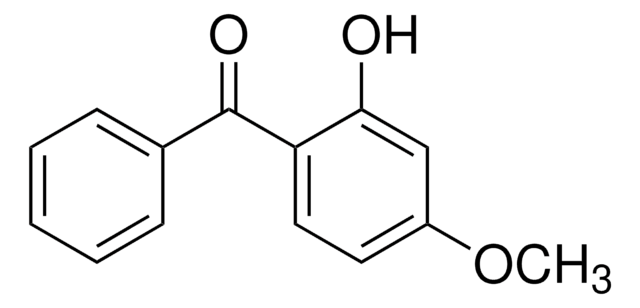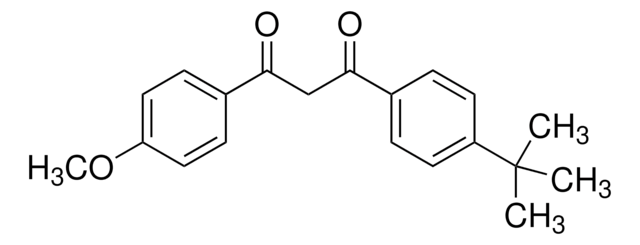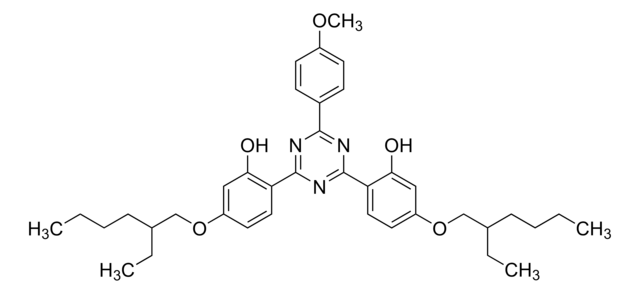78848
2-Ethylhexyl 4-methoxycinnamate
98%
Sinônimo(s):
4-Methoxycinnamic acid 2-ethylhexyl ester, OMC, Octyl methoxycinnamate
Faça loginpara ver os preços organizacionais e de contrato
About This Item
Fórmula empírica (Notação de Hill):
C18H26O3
Número CAS:
Peso molecular:
290.40
Beilstein:
5946632
Número CE:
Número MDL:
Código UNSPSC:
12352108
ID de substância PubChem:
NACRES:
NA.25
Produtos recomendados
Nível de qualidade
Ensaio
98% (GC)
98%
Formulário
liquid
índice de refração
n20/D 1.545
cadeia de caracteres SMILES
CCCCC(CC)COC(=O)\C=C\c1ccc(OC)cc1
InChI
1S/C18H26O3/c1-4-6-7-15(5-2)14-21-18(19)13-10-16-8-11-17(20-3)12-9-16/h8-13,15H,4-7,14H2,1-3H3/b13-10+
chave InChI
YBGZDTIWKVFICR-JLHYYAGUSA-N
Procurando produtos similares? Visita Guia de comparação de produtos
Descrição geral
OMC provides protection against UV induced cyclobutane pyrimidine dimer (CDP) formation, filtering UVB.
Aplicação
- Simultaneous electrochemical determination of three sunscreens using cetyltrimethylammonium bromide.: This study presents an electrochemical method for the simultaneous determination of sunscreens, including 2-Ethylhexyl 4-methoxycinnamate, using cetyltrimethylammonium bromide, highlighting the importance of analytical techniques in biochemistry (Cardoso et al., 2008).
- Relationship between the ability of sunscreens containing 2-ethylhexyl-4′-methoxycinnamate to protect against UVR-induced inflammation, depletion of epidermal Langerhans (Ia+) cells and suppression of alloactivating capacity of murine skin in vivo.: This study evaluates the protective effects of sunscreens with 2-Ethylhexyl 4-methoxycinnamate against UV radiation-induced skin changes, contributing to the understanding of immune responses in dermatological biochemistry (Walker et al., 1994).
Frases de perigo
Declarações de precaução
Classificações de perigo
Aquatic Chronic 4
Código de classe de armazenamento
10 - Combustible liquids
Classe de risco de água (WGK)
WGK 2
Ponto de fulgor (°F)
379.4 °F
Ponto de fulgor (°C)
193 °C
Equipamento de proteção individual
Eyeshields, Gloves
Escolha uma das versões mais recentes:
Já possui este produto?
Encontre a documentação dos produtos que você adquiriu recentemente na biblioteca de documentos.
Os clientes também visualizaram
Nur Duale et al.
Toxicological sciences : an official journal of the Society of Toxicology, 114(2), 272-284 (2010-01-15)
Octyl methoxycinnamate (OMC) is one of the most widely used sunscreen ingredients. To analyze biological effects of OMC, an in vitro approach was used implying ultraviolet (UV) exposure of two human cell lines, a primary skin fibroblast (GM00498) and a
Yida Zhang et al.
Analytica chimica acta, 876, 55-62 (2015-05-23)
A novel cedar-like Au nanoparticles (AuNPs) coating was fabricated on an etched stainless steel (SS) wire by direct chemical deposition and used as an efficient and unbreakable solid phase microextraction (SPME) fiber. The etched SS wire offers a rough surface
Juan L Benedé et al.
Talanta, 147, 246-252 (2015-11-26)
In this work, a new approach that combines the advantages of stir bar sorptive extraction (SBSE) and dispersive solid phase extraction (DSPE), i.e. stir bar sorptive-dispersive microextraction (SBSDµE), is employed as enrichment and clean-up technique for the sensitive determination of
Wenlan Song et al.
Journal of chromatography. A, 1384, 28-36 (2015-02-11)
A novel zinc-zinc oxide (Zn-ZnO) nanosheets coating was directly fabricated on an etched stainless steel wire substrate as solid-phase microextraction (SPME) fiber via previous electrodeposition of robust Zn coating. The scanning electron micrograph of the Zn-ZnO nanosheets coated fiber exhibits
S C Cunha et al.
Environmental research, 143(Pt B), 65-71 (2015-05-20)
In the last decades, awareness regarding personal care products (PCP), i.e. synthetic organic chemicals frequently used in cosmetic and hygienic products, has become a forward-looking issue, due to their persistency in the environment and their potential multi-organ toxicity in both
Nossa equipe de cientistas tem experiência em todas as áreas de pesquisa, incluindo Life Sciences, ciência de materiais, síntese química, cromatografia, química analítica e muitas outras.
Entre em contato com a assistência técnica








